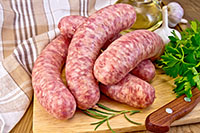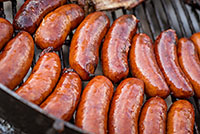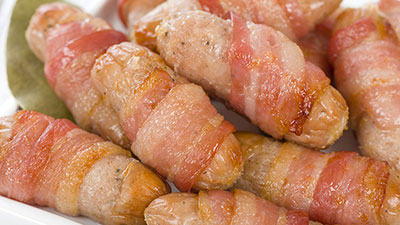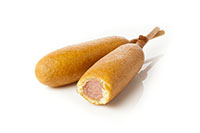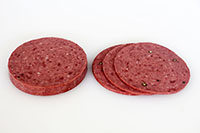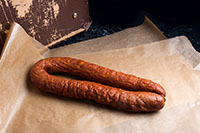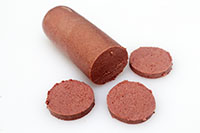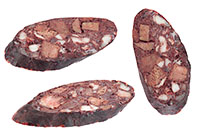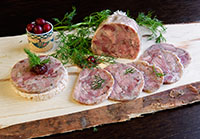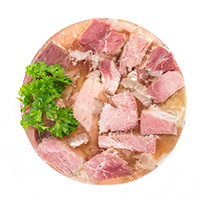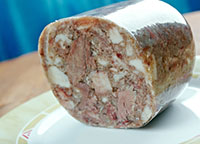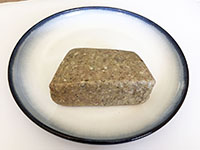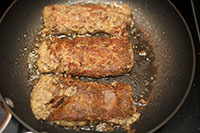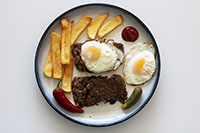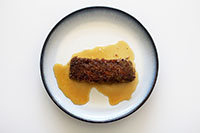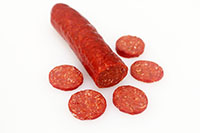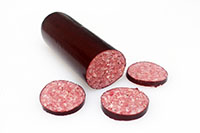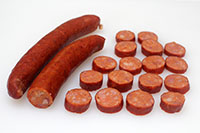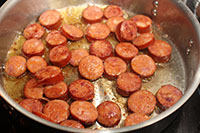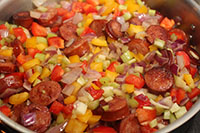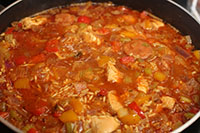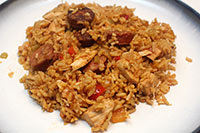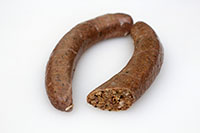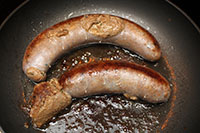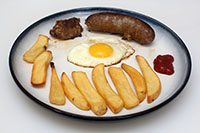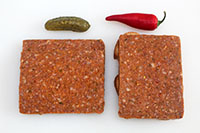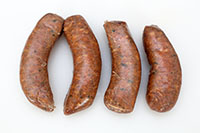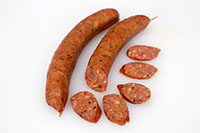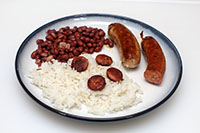Meats and Sausages
American Sausages
The Americans may eat a lot of sausages be weight, but the variety of sausages available in supermarket is very limited. Hot dog, bologna and grill type fresh sausages account for the majority of all sales. Compared with his European counterpart, an average American consumer knows very little about sausages.
In earlier days the immigrants from countries like Germany, Italy, Poland, Russia and others, have brought their sausage making skills and opened butcher shops that were around every corner. There was a great variety of traditionally produced European style meats and abundance of sausages. A local consumer was a friend of a butcher and was familiar with all of his products. People were familiar with head cheese or a blood sausage, something that is unheard of today, unless we visit small European store. The huge supermarket chains were not present yet and many small to medium size meat plants produced sausages. Every meat store was making a variety of meat products and sausages.
Consolidation of meat industry carries the blame; huge meat processors produce thousands of pounds of a few sausages which are most profitable. A local butcher shop cannot compete on a price basis with a huge factory as the average consumer is not the quality but the price oriented. Popular once sausages are being forgotten, recipes are modified, it all looks and tastes similar.Let’s go through some of the sausages that are commonly available.
Fresh Sausages
Bratwurst - Bratwurst - is a common type of sausage in the United States which was originally brought to North America by German immigrants. Bratwurst became popular in 1920s in Wisconsin, the state with a significant German population. As it is a great sausage for outdoor activities, each butcher will make a fresh bratwurst for a particular occasion and the sausage will be grilled later on. In time bratwurst became popular all over the country and can be found in every supermarket today. Bratwurst is a fresh sausage which does not look impressive, however, it comes alive when grilled.
Italian Sausage - a wonderful sausage for frying or grilling and can be found in every supermarket in the USA. The dominant flavor in fresh Italian sausage is fennel and by adding (or not) cayenne pepper we can create sweet, medium or hot variety. Fried on a hot plate with green bell peppers and onions, it is sold by street vendors everywhere in New York City.
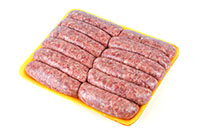
Cooked Sausages
Hot Dog - A finely comminuted fully cooked 5-6” (12-15 cm) long, 3/4” (20 mm) sausage originally made from pork or pork/beef combination. First hot dogs were stuffed into natural casings, then as the technology improved a skinless version was introduced. Emulsified meat for the skinless hot dog is stuffed into a long tube of thin cellulose that is removed after cooking. Hot dogs are served hot by boiling in water or grilling and usually served in a roll with mustard, ketchup, sauerkraut or relish. Street vendors selling hot dog from their carts are common site in large cities. Although immensely popular the hot dog is a low-quality sausage made today from different meat trimmings, including chicken, turkey, machine recovered meat from bones and a significant amount of added water.

Hot dogs are offered in many versions for example:
Frankfurter - The the frankfurter is a cured, smoked and cooked sausage. It is a ready to eat sausage or it may be boiled, fried or grilled for serving. Frankfurter is similar to hot dog, however, it is slightly longer and usually contains more beef what make the sausage darker than hot dog. The frankfurter originated some 350 years ago, in Frankfurt, Germany and German immigrants brought the technology to the USA. The terms frankfurter, wiener or hot dog are practically interchangeable today. When the term “beef frankfurter” is used, the sausage is made of pure beef only.
Bologna - American sausage, sometimes phonetically spelled baloney, is derived from Italian mortadella, a finely ground large pork sausage containing cubes of lard, originally from the Italian city of Bologna. U.S. Government regulations require American bologna to be finely ground and without visible pieces of lard. American bologna can be made from pork, chicken, turkey, beef, venison, combined or soy protein. Typical seasoning for bologna includes black pepper, nutmeg, allspice, celery seed, coriander, and like mortadella, myrtle berries give it its distinctive flavor.
Polish Sausage - An American version is anything stuffed into 32-36 mm casing, about 12 inches long, often in a form of a loop is called Polish sausage. This is a marketing trick to dupe a customer into believing that he is buying a Polish quality sausage. Those sausages have nothing in common with sausages in Poland. Polish sausages have names: Krakowska, Mysliwska, Kabanosy, Szynkowa and over 100 sausages more. There is only one sausage called Polish Smoked Sausage and it is made from pork, salt, cure #1, pepper, marjoram and garlic. Look at the ingredients list on a commercially produced item – the ingredients list is endless and each manufacturer uses different meat and spice combinations.
Goetta - An American sausage popular in the area of Cincinnati. It is made of pork, beef, fresh onions, starch, and whole grain, steel cut oats and stuffed into large diameter casings. To serve: slice the Goetta into patties, and pan fry. Very similar to serving scrapple. Relatively a new sausage, in 1946 Robert Glier first made goetta at his butcher shop in Covington, Kentucky, across the river from Cincinnati.
Texas Hot Links - Smoked and baked sausage made from pork or pork and beef. The sausage contains a large amount of black pepper, red pepper and/or cayenne since the term hot link.
Liver Sausages
Braunschweiger - Liver sausage from Germany. American braunschweiger is usually smoked and contains at least 30% of liver.
Blood Sausages
Blood Sausages - In all parts of the world people love blood sausages except the USA. I have asked for a blood sausage in the large supermarket in Florida and the sales lady did not know what it was. Being a friendly person she submitted the question to her manager who came over but he also did not have the slightest idea what I was talking about. Blood sausages were popular in the past in the USA as there are recipes in old books, however, mention blood sausage to an average American consumer today and he is looking the other way. Yet mention blutwurst to a German, black pudding to an Englishman or morcilla to a Spaniard and you will see a spark in the eye.
It seems there is a preconceived opinion on these products. When people hear blood sausage they imagine that blood is bad and they look the other way. Then, they go to a restaurant, order a medium rare steak and lick every drop of blood that is left on the plate. Fully cooked blood in a sausage is not acceptable but raw fresh blood in a steak is fine...Not easy to figure out that one. Like caraway or garlic you either love it or you hate it. It is not the taste that people hate, because cooked blood does not taste bad at all, but the idea of eating blood. Cooked blood sausage is not red anymore, in addition it contains a few calories and is rich in zinc and iron.
Head Cheeses
American Head Cheese - In English the name head cheese doesn’t sound appealing which prevents many people from trying the product. In other languages, it is called in a friendlier manner, without the word “head” being part of the name. Traditionally head cheese was made entirely from the meat of the head of a hog, cured and stuffed in large beef bungs or in pork stomachs. We may find this choice of meat today less appealing, forgetting at the same time the fact that pork head meat is highly nutritional and flavorsome. Persons living in metropolitan areas cannot buy pork head anyhow but still can make a great tasting product by using pork picnic and pigs feet, skins, tongue, heart and meat trimmings. When vinegar is added, it is called “souse” and this already sounds much better. Head cheese, brawn, or souse are not cheeses, but rather jellied loaves or sausages that may or may not be stuffed into the large diameter casing. They can be easily found in places that cater to Central Europeans, Eastern Europeans and Italians. Head cheese is sometimes called “brawn.”
Souse - Also known as Sulz is a head cheese to which vinegar has been added. It is a jellied meat sausage that is stuffed in a large diameter casing or simply as a jellied meat loaf. As most people add vinegar or squeeze some lemon juice into head cheese when eating it, so it should not be a surprise that producers add vinegar (5%) into the mix. This added the benefit of a longer shelf life of the product as all foods containing vinegar last longer. The reason is an increased acidity of the product which inhibits the growth of bacteria. Souse is similar to sulz but not limited to pig's feet only.
Scrapple - A popular ethnic food of the Pennsylvania Dutch, descendants of late 17th and early 18th century immigrants to Pennsylvania, Maryland, Virginia and North Carolina from southern Germany, eastern France (Alsace and Lorraine) and Switzerland. Scrapple is something like a meaty fried polenta, cornmeal to which seasonings and relatively lean cooked meat, usually pork, have been added. The cooked mixture is poured into loaf pans and refrigerated overnight to stiffen. Then it is sliced and fried in a little butter, oil or bacon grease. It looks like a fried slice of a meat loaf.
The traditional scrapple recipes employed meats cuts and trimmings that would originally go to waste such as hog offal i.e., head, heart, liver, and other trimmings, which were boiled with any bones attached (often the entire head), to make a broth. Once cooked, the meat was separated from bones, finely chopped and returned to meat broth in which the (dry) cornmeal or buckwheat flour was boiled to make a mush. As many early settlers came from Germany so it comes as no surprise that the Pennsylvania Germans preferred buckwheat for thickening scrapple as buckwheat was always very popular in Germany, Poland and Russia. In those countries buckwheat groats are often added to blood sausages. Finally, seasonings, typically sage, thyme, savory, black pepper, and others were added to broth.
The ingredients used for making scrapple as well as the manufacturing process itself closely resembles production of a head cheese and that is why we have placed scrapple in head cheese category.
Fermented Sausages
American fermented (salami type) sausages differ greatly from Italian, Spanish, Hungarian or French products in that they are speedily produced. To produce in a short time a safe uncooked sausage requires more acidity (larger pH drop) and that creates a sourly tasted sausage. A compromise is usually achieved by introducing acceptable acidity (moderate amount of sugar) and partially cooking the sausage. This, however, will never produce a cheese flavor and a characteristic texture of traditionally produced dry salami.
Lebanon Bologna is a Pennsylvania Dutch prepared meat. While nominally bologna, it is a dried, smoked sausage similar to salami.
This well-known American sausage has its roots in the town of Lebanon, Pennsylvania, where it was made by German settlers. Lebanon Bologna is a semi-dry, fermented, heavily smoked, all-beef sausage which is not cooked. The traditional process (no starter cultures) calls for curing beef at 4-6º C (40-43º F) for 10 days.
Pepperoni also known as pepperoni sausage, is an American variety of salami. Traditional pepperoni is a dry sausage, smoked, air dried, sometimes cooked. Pepperoni can be made from beef, pork or a combination such as 30% beef and 70% pork. Pepperoni is a lean sausage with fat content < 30%. Cheaper, fast-fermented (semi-dry) and cooked types end up as toppings to pizzas worldwide to give flavor. Traditionally made Italian pepperoni was not smoked.
Pepperoni sausages are commonly sold in two sizes: an inch or so in diameter for pizza and two to three inches in diameter for sandwiches. Pepperoni is sold whole, chopped, or in slices, and is commonly found in American deli counters.
Summer Sausage - An American semi-dry fermented sausage, made of pork and beef, although sausages made from beef alone are common. The sausage was made in the winter time and after drying and storing it was consumed in the summer when working in the field. Summer sausage displays a long shelf life without refrigeration and is often used as a component of food for gift baskets along with different cheeses and jams. Diameter of casings varies from 40-120 mm and so does the length of the sausage.
Cajun Sausages
Without a doubt the Cajun sausages display the most of originality and unique character of all American sausages. The names of the sausages might be French: Andouille or Boudin, but the recipes have been modified and adapted to local conditions. Some animals and vegetation found right conditions to grow and survive a hot and humid climate of Louisiana resulting in a unique cuisine. Cajun food is the combination of French traditional recipes, local Creole dishes and the imagination and the survival instincts of the local people.
Cajun food comes from the Southern parts of Louisiana and Mississippi and is spicy, rich, and really good. The typical Cajun food was developed by extremely poor people who in 1755 were forced out of their settlements in Acadia, Canada by the British, eventually settling in Southern Louisiana. Due to the extreme change in climate, the new French- speaking immigrants were unable to cook their original dishes and would cook whatever fresh food was ready and available and this tradition is still alive in many places today, you eat what you catch.
Refugees and farmers used what they had to feed large families. This is one reason that rice is a staple in Cajun food. Since Cajun people are so close to the Gulf of Mexico, seafood is a big item in their dishes. Favorites are crawfish, catfish, crabs, and oysters. Bell pepper, onions and celery are the favorite vegetables to add flavor for the Cajun food. It is referred to as the ‘Holy Trinity.’ Cayenne pepper and garlic are other favorites.
A hot and humid climate of Louisiana was not suited for cattle and it required animals that could adapt to harsh conditions. The swamps are filled with alligators, snakes, different fish, however, the pig is a smart creature that feels at home around humans and can survive in the wild under any conditions. It gains weight fast, eats anything so it is not surprising that pork is material of choice for Cajun sausages.
Andouille - Cajun is the sausage most often associated with Louisiana Cajun cuisine. This is a coarse-grained smoked sausage made with pork, garlic, pepper, onions, wine, and seasonings. The town of LaPlace, Louisiana, on the Mississippi River, is especially noted for its andouille. In France, andouille was traditionally made with pig chitterlings, tripe, onions, wine, and seasoning. It is generally grey in color and has a distinctive odor. A smaller sausage is called andouillette, literally "little andouille." Andouille is used for gumbos (Cajun stews) or grilled.
Andouille is often added to jambalaya. What differs jambalaya from gumbo and other dishes is that the rice is not cooked separately, but is added with sufficient amount of meat stock to fried sausage and vegetables. Then, all is slowly cooked until rice is done.
Boudin - A French sausage which comes in two varieties:
Boudin Noir - Made with blood which is a blood sausage, also known in England as Black Pudding.
Boudin Blanc - Made without blood, the sausage is known in England as White Pudding.
Boudin Cajun - Understood to be boudin blanc (no blood) and is available in southern Louisiana, particularly in the Lafayette, Lake Charles, Alexandria and Baton Rouge, though it may be found in convenience stores along Interstate 10. Also popular is seafood boudin consisting of crab, shrimp, and rice. Unlike andouille and chaurice which are served with other foods, Boudin is sold already cooked and eaten hot. The main materials are pork, pork liver and rice and this combination gives boudin its characteristic taste and flavor.
Cajun Head Cheese - a thick head cheese made with finely comminuted meat and paprika what accounts for its deep orange color. Crushed red peppers (pizza variety) are added to make a hot Cajun Head Cheese.
Chaudin - Also known as Ponce is a stuffed pig's stomach with pork sausage ingredients. It is difficult to find Chaudin in metropolitan areas but, take a short drive north of Lafayette and you will find the dish. Either smoked or unsmoked, the ponce is roasted or braised for a couple of hours and usually served with rice. It is often cooked in a Holy Trinity Gravy: make a roux, brown chopped onion, bell pepper, celery and garlic. Add water, broth or wine to make a gravy, put the chaudin in the gravy and slow cook, covered, until is done. Slice and serve over rice.
Chaurice - A coarsely ground, spicy Cajun pork sausage which may or may not be smoked. It contains green onions, onions, celery, parsley, garlic and cayenne pepper. Chaurice has been traditionally served in chunks with red beans and rice or pan fried and served with a vegetable stew or lentil soup.
Final Note
The USA is a young country and has not had time to develop its own traditional products the way Europe did. What is also of significance is that the best material for making sausages is pork and the pigs were not known in America. The first pigs were introduced in the 1500’s to what is now the southeastern U.S. by Spanish Explorer, Hernando De Soto. Natives were hunting animals and drying meats, but did not develop sausage making skills. This knowledge was brought be European settlers so whatever products we see today are modified European sausage recipes.
In Europe certain sausages have been made the same way for centuries so many consumers are familiar with the recipes. The original European recipes gave been changed or adapted to local meats and spices and new recipes are continuously invented by creative cooks. They want to be original and we have sausages with apples, nuts, tofu, soya and whatever is edible. We don’t include such recipes in this section, but feel free to experiment yourself.
American sausages
The following American sausage recipes are listed in our Sausage Recipes Index:
- Andouille - fresh
- Blood Sausage with Jowls - blood sausage
- Blood Sausage with Snouts - blood sausage
- Blood Sausage with Tongues - blood sausage
- Bologna-American - cooked
- Bologna-Country Style - cooked
- Boudin - cooked
- Bratwurst - fresh
- Braunschweiger - liver sausage
- Breakfast - fresh
- Chaurice - cooked
- Frankfurter - cooked
- Frankfurter Coney Island - cooked
- Italian Sausage - fresh
- Lebanon Bologna Traditional - fermented
- Lebanon Bologna with Culture - fermented
- Traditional Head Cheese - head cheese
- Hot Dog - cooked
- Liver Sausage-American - liver sausage
- Navajo - blood sausage
- Pepperoni Dry - fermented, dry
- Pepperoni Semi Dry - fermented, semidry
- Polish Hot Smoked - cooked
- Pork Sausage-American - cooked
- Pork Sausage with Flour - fresh
- Salami-All Beef - fermented
- Salami Cotto - cooked
- Kosher Salami - fermented
- Scrapple - cooked, head cheese
- Scrapple-Traditional - cooked, head cheese
- Souse - head cheese
- Sulz - head cheese
- Summer Sausage - fermented
- Tomato Sausage - fresh

